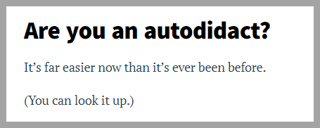
Your article of 1,000 words to 3,000 words is profound, valuable and better than any Wikipedia page. You have many years of experience and believe "the answer" is within your content and you would like nothing better than to share it with the world.
Should you publish the entire article whole as-is? Or divide it into multiple articles?
#1 - Some folks believe:
When creating content for those truly interested and in need, give them your very best - don’t hold back. The length is irrelevant because it’s about ensuring they no longer need to search and they get the information to take action.
#2 - Other folks make the point that:
Studies show: People read 25% slower on a screen and quit reading much earlier. This research, combined with the behaviors/time management that people use their “micro-minutes” to consume content, leads us to believe that “short bursts” of content are more helpful to people.
And so...
If you believe #1 is true for those you serve, then publish article regardless of length. Include sub-titles and bullets to help them read the article on a screen much easier.
Or...
If you believe #2 is more true for those you serve, then split the article publish them independently. Use the subtitles in an article titles to create three, four or more articles.
The “who” you build content for will determine which direction to go.
Example of a snack:
Seth Godin usually goes with quick shots. We see the email or article is short, so we are willing to take a moment to read it for an “ah-ha.”
A recent article from Seth is simple and straightforward:

Which is best?
There is no right or wrong, best or worst when deciding whether to post a full article in all its glory or split into quick content snacks. Nor is there a formula. (Though data experts will show graphs and charts that proves either is more effective.)
i.e. - There is data that shows top ranked articles are longer. According to a HubSpot study from 2021, the ideal blog post length for SEO should be 2,100-2,400 words. BUT when you take into consideration the subject matter and searchers' intent, the "ideal length" becomes secondary.
i.e. - If you are writing content for contacts who already follow you (LinkedIn or email contacts), "cut to the chase" is the objective.
It might be good to point out that each on of the article titles becomes a "search" opportunity as they focus on a more specific topic, referred to as "long-tail keywords."
Variable:
If those who are connected and follow you are BIG fans, they will go out of their way to capture every word you offer. Longer content that might be challenging is "worth their time" because they want to learn from you.
On the other hand... Those who are new to you and still wondering about your character and expertise, they will prefer quick samples. Are you too good to be true? Are you committed, or working on "tricks" for attention and a credit card?
Topic and title source:
If you are listening well first, and "feeding the market" instead of "creating a market," the topics and titles will come directly to you. Everyone has their favorite form of "listening." Some use data, others use surveys, events, networking forums
Action:
- Group, forum, membership, and event participation leads to new questions from the people you connect with. Join, participate and write down the questions. (Focus and be helpful vs. spreading yourself out to everyone.)
- DON'T= Create content for "marketing."
DO = Create content for service.